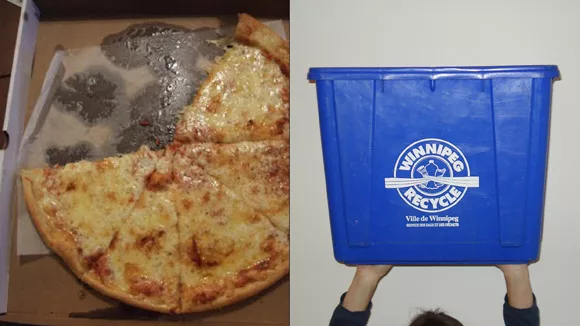We at Green Action Centre often hear from people asking what they can do with paper products like heavily soiled pizza boxes that they are told they should not recycle. What do you do when you are faced with this situation? Can you put it in your compost bin?
Tell us about your experience with paper products that you can’t recycle.
Myth Busted!
Most paper materials are both recyclable and compostable. The question might be which is the best option for a specific situation. For paper that is not recyclable, such as that greasy pizza box, the options are either compost it or throw it in the trash. Composting is definitely the better option here and based on the responses to our myth, just tear it up into small pieces and toss it in. One Green Action Centre staffer says that she tears off the parts that are not greasy, like the top and sides, and recycles that portion. The greasy part goes to the compost bin.
Kevin’s response to the myth got a discussion on the thermal paper used for receipts and whether the BPA contained in these receipts represented a serious concern for your compost. No clear answer emerged from the discussion and it would appear that more research may be needed on this subject. While receipts represent only a very small proportion of the final compost product, for now each of us will have to decide for ourselves whether these are better recycled and kept out of our compost.
A question that did not emerge from this discussion was whether it is better to recycle paper or compost it? It’s great that we have two alternatives for our waste that doesn’t involve sending it to the landfill and in some cases we need both.
When it comes to most paper, recycling is the slightly better option. One of the reasons for this is that when we recycle our paper we reduce the number of trees that need to be harvested. In addition recycling paper requires less energy, uses less water, and creates less air pollution than paper production from virgin materials.
There are those times however when composting is the better alternative. We already know that those greasy pizza boxes are best composted, but are there other paper products that are better composted? Well there are those soiled napkins and tissues that you can’t recycle. And what about that shredded paper, might it be better to compost? It’s already in small pieces and will break down quickly in your compost pile. If you check out the City of Winnipeg’s FAQ’s on recycling you’ll find that you need to pack it tightly in your Blue Box or you can put it into a large (77 litre) see through plastic bag. These large bags are then separated from the rest of the recycling and emptied by hand before the rest of the recyclables go through the automated plant. Once again each of us needs to decide for ourselves what works best, but please make sure that you keep it from blowing down the street.
There are also some papers that shouldn’t be recycled or composted such as glossy magazines and foil wrapping paper. These types of paper have strong dyes, heavy inks and other printing chemicals that make them unsuitable. The best option is to avoid them in the first place.

